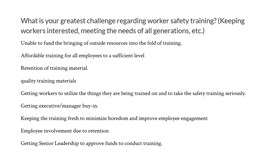Training daze?
Experts discuss ways to keep training fresh, relevant

To Dan Snyder, this is a typical email announcing workplace safety training: “Safety training, 9 o’clock on Monday. Be there or be square.”
It’s a simple, uniform message on the surface, but in Snyder’s experience, this kind of “check the box” approach often breeds frustration and apathy among workers – and could result in fewer attendees in the training room.
Safety+Health recently discussed strategies for improving safety training attendance and engagement with Snyder, president and CEO of SPAN International Training LLC, as well as veteran safety consultant Carl Potter, founder and CEO of the Safety Institute, and David Consider, senior workplace consultant and trainer for the National Safety Council.
Presented in conjunction with S+H’s fourth annual Training Survey, here are six highlights from the conversations.
Consider your workers
What if 9 a.m. Monday is a convenient training time for one segment of your workforce but falls near a production deadline for another? What if scheduling training at that hour means a potential drop in interest among third-shift workers eager to clock out for the day once the session ends?
Coordinating the scheduling of training events between an organization’s management team and other supervisors is a critical first step to building a sustainable training culture, Snyder said. Whether organizations opt for different start times or offer multiple dates for the same training, a little compromise goes a long way.
“When management is informed of the purpose for a safety training event and agrees to the added value to operational performance, schedules should be established with enough notice for operations to make arrangements for learners to attend the training,” Snyder said.
‘Right-size’ me
Workers frequently hear that training is vital to protecting the workforce. They’re also aware that time and training budgets are often limited.
“Training keeps organizations competitive by exposing employees to the latest cutting-edge information and ensuring their knowledge and skills are being honed regularly,” Consider said. “The goal is to have employees bring new skills and ideas back to the workplace that are more likely to be able to provide innovative solutions to new issues.”
Potter suggests evaluating training content well in advance of scheduled sessions to eliminate extraneous or irrelevant information. Assess the scope of the audience and the aim of the training to better pinpoint its flow and direction.
“If all they need to know is how to tell time, why are we teaching them how to build a watch?” Snyder said. “By right-sizing the training, a safety professional can optimize both budget and time, making the business case for relevant and effective safety training.”
Mix it up
Computer-based training may be ubiquitous, but Potter contends it “can’t be so big that they’re spending hours and hours. I mean, people can’t just stay engaged that long and learn.”
That’s why Potter champions incorporating blended learning techniques to cater to various adult learning styles. Combine elements such as computer modules, small group discussions, case studies and short lectures to diversify delivery during the session and increase attendees’ involvement and investment.
One example Potter gave involved completing a series of short computer training modules in the morning before lunch, then concluding the training with a discussion review and post-test. “Or if it’s something like CPR training, first aid, you can get all the rote learning – the stuff that they need to memorize – done,” he said, “and then go do the practical, hands-on of putting Band-Aids on, actually doing the CPR and those kinds of things so they can demonstrate the demonstratable things.”
Generation station
Although Snyder acknowledges the “nuanced differences between multigenerational workers” in many industries – namely those pertaining to technology – he also cites research showing that adults fundamentally learn in the same way regardless of age. This can be especially valuable information for instructors when strategizing delivery methods for tactile, “how to” training for physical job activities.
The instructor doesn’t have to reinvent the wheel in this instance.
“If I’m teaching somebody how to properly hook up a harness, that’s a hands-on activity demonstration,” Snyder said. “And it really doesn’t matter if the worker is 18 or 80 – they’re going to put on a harness the same way.”
(Virtual) class is in session
“Probably the most expensive thing about training is actually the time for travel” for instructors and learners, Potter said.
For organizations looking to mitigate budget concerns while also integrating technology, using a live webcam with two-way audio communication to create a virtual classroom is an emerging option, in Potter’s view.
“I can present the same material that I can present right face to face with them,” Potter said. “And as long as they’ve got that module and they’ve got the ability to discuss with me, I can have a pretty good classroom experience with them.”
What’s in a name?
Is there a difference between safety training and safety education? Snyder says “yes,” although he quickly notes that both “represent critical elements” of occupational safety and health management systems.
“Safety training and educational initiatives should be designed to solve knowledge, skill, ability and attitude performance gaps,” Snyder said. “In general terms, the purpose of training is how to do something for a specific task, such as [personal protective equipment] selection and following [lockout/tagout] procedures. Whereas education is designed to deliver knowledge or awareness about something that may be transferred to many contexts, such as situational awareness and operational hazard/risk assessment.”
Consider views training as a cycle that – when executed properly – has the potential to benefit an entire organization. Successful training programs are likely to attract quality employees who value the ability to seize opportunities for professional development, he said.
“By putting time and money into building employees’ skills and engagement opportunities,” Consider said, “loyalty and ownership within the organization increases and generally makes employees happier, as everyone loves to feel valued.”
| Next: 2019 Training Survey results: Expenditure | > |
Post a comment to this article
Safety+Health welcomes comments that promote respectful dialogue. Please stay on topic. Comments that contain personal attacks, profanity or abusive language – or those aggressively promoting products or services – will be removed. We reserve the right to determine which comments violate our comment policy. (Anonymous comments are welcome; merely skip the “name” field in the comment box. An email address is required but will not be included with your comment.)





